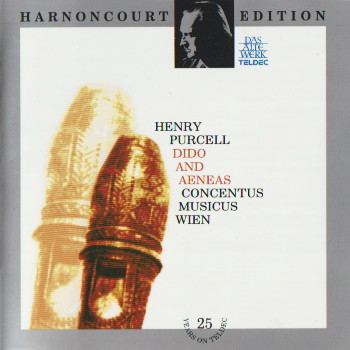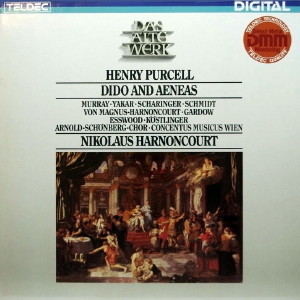 |
1 CD -
Teldec 8.42919 XH (c) 1989
|
 |
| 1 LP -
Tedec 6.42919 AZ (p) 1983 |
|
| NIKOLAUS HARNONCOURT - 25 Years
on TELDEC |
|
|
|
|
|
|
|
| Henry Purcell
(1659-1695) |
Dido
and Aeneas - Opera in 3 acts,
libretto by Nahum Tate |
|
|
|
|
|
|
|
|
|
Overture |
|
2' 53" |
A1 |
|
ACT I |
|
14' 59"
|
A2 |
|
- Song
(Belinda) & Chorus "Shake
the cloud from off your brow" |
1' 06"
|
|
|
|
- Song (Dido) "Ah!
Belinda" |
4' 08"
|
|
|
|
-
Recitative & Song (Belinda &
Dido) "Grief
increasing by concealing" |
0' 32"
|
|
|
|
-
Chorus "When
monarchs unite" |
0' 14"
|
|
|
|
-
Recitative (Dido & Belinda) "Whence
could so much virtue spring?" |
2' 13"
|
|
|
|
- Duet (Belinda & Second
Woman) & Chorus "Fear
no danger" |
1' 36"
|
|
|
|
-
Recitative (Belinda, Aeneas & Dido) "See,
your royal guest appears" |
0' 50"
|
|
|
|
-
Chorus "Cupid
only throws the dart" |
0' 35"
|
|
|
|
-
Recitative (Aeneas) "If not
for mine, for Empire's sake" |
0' 23"
|
|
|
|
- Song
(Belinda) "Pursue
thy conquest, Love" |
0' 51"
|
|
|
|
- Chorus "To
the hills and the vales" |
1' 20"
|
|
|
|
- The
Triumphing Dance |
1' 21"
|
|
|
|
ACT II - Scene 1 |
|
8' 25" |
A3 |
|
-
Recitative (Sorceress) "Wayward
sisters" |
2' 31"
|
|
|
|
-
Chorus "Harm's
our delight" |
0' 14"
|
|
|
|
-
Recitative (Sorceress) "The
Queen of Carthage" -
Chorus "Ho ho ho" |
0' 52" |
|
|
|
-
Recitative (Witches & Sorceress)
"Ruin'd
ere theset of sun" -
Chorus "Ho ho ho" |
1' 30" |
|
|
|
- Duet
(Witches) "But
ere we this perform" |
1' 10" |
|
|
|
-
Chorus "In our
deep vaulted cell" |
1' 07" |
|
|
|
- Echo
Dance of Furies |
1' 01" |
|
|
|
ACT II - Scene 2 |
|
8' 08" |
B1 |
|
-
Ritornelle |
0' 57" |
|
|
|
- Song
(Belinda) & Chorus "Thanks
to these lovesome vales" |
1' 15" |
|
|
|
- Song
(Second Woman) "Oft
she visits this loved mountain" |
1' 38" |
|
|
|
-
Recitative (Aeneas & Dido) "Behold,
upon my bending spear" |
0' 35" |
|
|
|
- Song
(Belinda) "Haste,
haste to town" |
0' 43" |
|
|
|
-
Recitative (Spirit & Aeneas) "Stay,
Prince" |
3' 00" |
|
|
|
ACT III - Scene 1 |
|
5' 57" |
B2 |
|
- Song
(Sailor) & Chorus "Come
away, fellow sailors" |
1' 32" |
|
|
|
- The
Sailor's Dance |
0' 51" |
|
|
|
-
Recitative & Duet (Sorceress &
Witches) "See
the flags and streamers curling" |
1' 06" |
|
|
|
- Song
(Sorceress) "Our
next motion" |
0' 41" |
|
|
|
-
Chorus "Destruction
our delight" |
0' 34" |
|
|
|
- The
Witches' Dance |
1' 13" |
|
|
|
ACT III - Scene 2 |
|
13' 07" |
B3 |
|
-
Recitative (Dido, Belinda & Aeneas)
"Your
counsel all is urg'd in vain" |
4' 52" |
|
|
|
-
Chorus "Great
minds against themselves conspire" |
1' 04" |
|
|
|
-
Recitative (Dido) "Thy
hand, Belinda" - Song
(Dido) "When I
am laid in earth" |
4' 24" |
|
|
|
-
Chorus "Whit
drooping wings ye Cupids come" |
2' 47" |
|
|
|
|
|
|
|
| Ann
Murray, Dido,
oder Elissa, Königin von Kurthago |
|
| Rachel
Yakar, Belinda,
ihre Schwester |
|
| Anton
Scharinger, Äneas,
ein trojanischer Prinz |
|
| Elisabeth
von Magnus-Harnoncourt, Zweite
Frau, Erste Hexe |
|
| Trudeliese
Schmidt, Zauberin |
|
| Helrun
Gardow, Zweite
Hexe |
|
| Paul
Esswood, Gespenst |
|
| Josef
Köstlinger, Seemann |
|
| Arnold-Schönberg-Chor,
Wien /
Erwin G. Ortner, Chorleitung |
|
| CONCENTUS MUSICUS
WIEN (mit Originainstrumenten) |
|
| Nikolaus
HARNONCOURT, Leitung |
|
|
|
|
|
Luogo
e data di registrazione |
|
Casino
Zögernitz, Vienna (Austria) -
marzo 1983
|
|
|
Registrazione:
live / studio |
|
studio |
|
|
Producer
|
|
- |
|
|
Edizione CD |
|
TELDEC
- 8.42919 XH (242 959-2) - (1 CD -
durata 54' 32") - (c) 1989 - DDD |
|
|
Originale LP
|
|
TELDEC
- 6.42919 AZ - (1 LP - durata 54'
32") - (p) 1983 - Digitale |
|
|
Note |
|
-
|
|
|
|
|
Long before 1724,
when Pietro Metastasio produced
“Didone abbandonata”,
his first independent opera
text which was to be setto
music on several occasions,
Henry Purcell’s “Dido and
Aeneas” had been performed in a
boarding school for “young
gcntlewomen” in Chelsea in
December (?) l689. Josias
Priests, the Head of
the stablishment,was
also a dancing master
at the Dorset Garden Theatre
in London, where he had
evidently got to know Purcell
who, not least for the benefit
of Priest, included a number of
dances in his opera; dancing was
at that time an essential
element in educatlon.
At the first performance
of "Dido and
Aeneas" Purcell himself
played the harpslchord. The
pupils performed on stage,
though the part of Aeneas, which
was written in the tenor
clef, may have been sungby
a member of the teaching
staff or of the Chapel
Royal.
In Book 4 of the “Aeneid" Virgil
describes how Aeneas, having
been driven out of
burning Troy, reaches the
court of the Carthaginian Queen
Dido. After a brief amorous
interlude, however, he obeys the
command of the gods to weigh
anchor once more. In the
struggle between love and
duty, (Roman)
self-sacrifice triumphs in
Virgil's epic. While Aeneua,
putting aside his personal
happines, bows to
the divine will. the
unhappy Queen commits
suicide.
In
Nahum Tate's libretto
il is not
really Jove at all who
reminds Aeneas of his historic
mission. In a typically English
adsptation of the classical plot
witches, in whose actual
existence many people may well
still have believed, cause
the destructtion of the
bonds of love that join
Dido and Aeneas. The Spirit
of a Sorceress, disguised as the
god Mercury, charges the hero to
leave Carthage and to set out on
the conquest of
Italy. Incidentally, in
comparison with the female title
role the character of Aeneas
remains rather colourless and
sketchily drawn. All the
additional
background of Virgil's epic
is cut out. At Dido'ss
side stands Belinda, the
typical "confidante”, well-known
in Venetian
Opera, a noblewoman in
the retinue of the Queen.
Henry Purcell’s “Dido and
Aeneas" is a work cast all in
one piece. And yet the
stimuli which are taken up in it
and fused
into a new whole
are stylistically quite
different. At the beginning of
Act l Belinda sings the aria
"Shake the cloud" ln a Venetian
da carlo form which still sounds
embryonic. Dido’s moving aria
"When I am laid in earth”
over an ostinato descending
chromatically through a fourth
is in the tradition of the
“Lamento Aria" which was
then fashionable not only
in Italian opera. The Echo
Chorus of the witches (“In our
deep vaulted cell”) owes a
debt to Lullly (quite apart
from the overture,
which is in the French
style, even though in this
case it is only in two
sections). In the chorus
Cupid only throwa the dart"
ans eòsewhere Purcell employs
the English madrigal
style- Several numbers, on
the other hand, bear a
resemblance to English folk song
and folk dance, such as the duet
leading up to the chorus "Dear
no danger", with its syncopation
in triple time, the chorus "To
the hills and the vales", tha
sailors' dance in the third act
or the sailors' chorus "Come
away, fellow silors" with its
typical Scotch snap on the words
"no never". Right up to the
moving final "funeral song"
"Whit drooping wings ye
Cupids come" Purcell allocates
an important role to the Chorus.
The arias are handled with great
variety, while there is nothing
yet of the rigid stereotype in
the often expression-packed
recitatives. The closest
approach to Purcell's score,
which has an unrivalled place in
the history of English opera, is
John Blow's miniature opera
"Venus and Adonis", written as a
Masque for the Court in 1685.
The history of the performances
of the opera can only be briefly
sketched. It is no longer
possible to discoverwhether it
was performed more than the once
at Josias Priest's establishment
in Chelsea. In the years 1700
and 1704 there certainly were
performances at the Little
Lincoln's Inn Fields Theatre,
where "Dido and Aeneas" was
inserted as a Masque in dramatic
performances (for example in
Shakespeare's "Measure for
Measure"). The revival of the
opera began in 1878 with a
concert performance by the Gluck
Society; in 1895, on the 200th
anniversary of Purcell's death,
"Dido and Aeneas" returned to
the London stage for the first
time. Its almost universal
acceptance did not occur until
1920's, when "Dido and Aeneas"
was staged in Münster and
Stuttgart, in Vienna, Paris and
New York and other cities. In
these performances widely
differing arrangements of
Purcell's masterpiece were used.
No really authentic score has
survived. The oldest extant
scores, not differing greatly
from one another in details of
either the text or the music,
were not copied until some sixty
years after Purcell's death.
Gerhard
Schuhmacher
(Translation: Lindsay
Craig)
|
|
|

